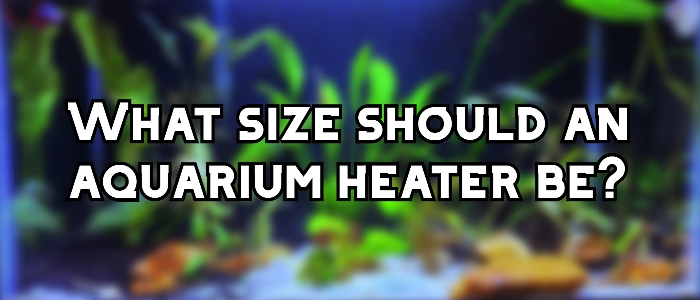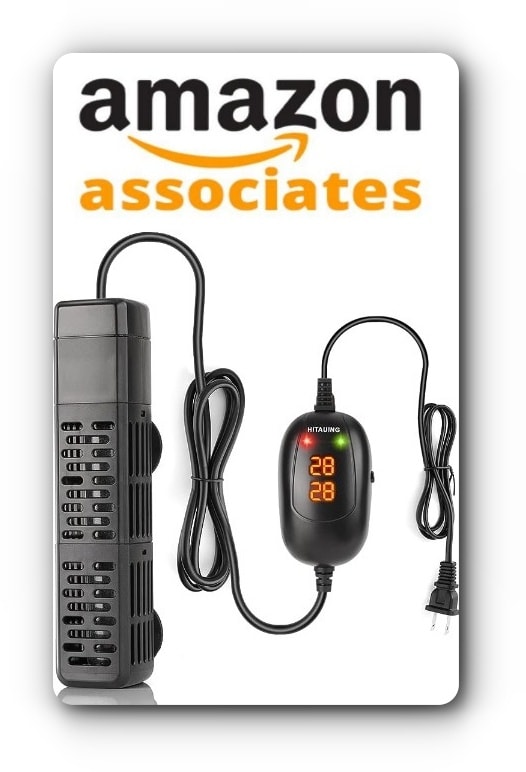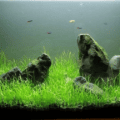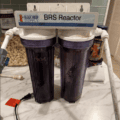In the world of fishkeeping, maintaining the right temperature in your aquarium is crucial for the health and well-being of your aquatic companions, especially when faced with chilly weather conditions. In this comprehensive guide, we delve into the essential factors to consider when selecting the ideal aquarium heater size for your tank.

This guide will help you find out the best aquarium heater size for your tank so your aquatic companions can feel warm and comfy even when it’s freezing outside.
For this purpose, I’m going to show you a formula that you can use to measure how much power you’ll need.
A rule of thumb to stay on the safe side with pet fish would be to have 5 Watts of heating power per 1 gallon of water.
However, playing around with formulas can be confusing, so I’ve also included a chart that will make things easier for you.
What’s the proper size for an aquarium heater based on gallon capacity?
Back when I was new to the whole fish-keeping thing I used to follow what big-chain pet stores recommended for aquarium equipment.
Obviously, it seemed easier not to bother with researching the equipment myself.
Needless to say, this brought a disaster onto the first fish tank I was personally responsible for.
A temperature swing obliterated all of my pet fish overnight.
Had I had a stronger and larger heater in the aquarium this could’ve been avoided.
So I decided to take matters into my own hands and do some proper research on the subject.
Here’s what I found:
It generally takes about 2.5 Watts of power to bring the temperature of a gallon of water by 1 degree in an hour.
However, during a temperature swing, 1 hour can prove to be a little too long for our pet fish to wait out. Most fish will be sensitive to such sudden movements in their tank’s temperature range. So I needed to approach the math conservatively, and calculate for no more than half an hour.
So here’s how to figure out what size aquarium heater you need:
Raising the temperature of a gallon of water by 1 degree Fahrenheit in half an hour requires 5 watts of energy. Therefore, an aquarium heater should give off 5 watts of heat for every gallon of water. This means a 10-gallon tank would need a water heater with a power of at least 50 watts.
After sticking to this rule I haven’t had issues with the temperature in my fish tanks during cold weather swings.
I’ve put together something like a summarized chart that shows how much wattage you need depending on the size of your aquarium. Take a look:
- For 5-gallon tanks: 25 Watts
- For 10-gallon tanks: 50 Watts
- For 20-gallon tanks: 100 Watts
- For 30-gallon tanks: 150 Watts
- For 40-gallon tanks: 200 Watts
- For 55-gallon tanks: 275 Watts
- For 75-gallon tanks: 375 Watts
- For 90-gallon tanks: 450 Watts
- For 125-gallon tanks: 625 Watts
A quick note about larger tanks:
Obviously, finding a stand-alone aquarium heater with a large Wattage would be difficult.
What you would want to do in such scenarios is get multiple heaters so that their total Wattage adds up to your target.
Having two 300-Watt heaters in a 125-gallon aquarium is perfectly normal and actually, I recommend doing it this way.
By having multiple heaters you “spread the risk”, because if one fails, the other would still support the temperature in the fish tank somewhat.
My advice is to always have an extra new heater at hand so that you can swap a failing one if an emergency occurs.
In my experience, temperature swings are one of the most common reasons for ill or dying fish in new home aquaria.
What will happen if the Wattage of your heater is too small for your aquarium?

A heater with Wattage that is too small for your aquarium will struggle to warm water to the ideal temperature.
It may be able to achieve the desired temperature at the site where you’ve placed it.
But chances are, the water will get colder as you move away from the heater.
Ultimately, the heater will probably need to run continuously to have a shot at warming the entire tank.
This is likely to take a toll on it, and your small tank heater may burn out sooner than if you used a size-appropriate one.
Oftentimes an aquarium heater fails when its element burns out, when the thermostat gets stuck or when the thermostat fails to turn on.
In case the ambient room temperature is relatively warm, your fish won’t notice that the tank heater isn’t working.
That’s why, when asked, I always recommend going for a heater rated for larger tanks than yours.
Most of the good aquarium heaters have a thermostat which tells the heater when it’s time to stop working.
The thermostat measures the aquarium’s temperature via a sensor and when the desired result is achieved the heater stops.
A more powerful heater does not mean warmer water. It means warming the water quicker. Which is what you should be after if you want to protect your fish from temperature swings.
Of course, the ability of fish to survive in colder temperatures depends on the type of species they are. But most pet fish in the hobby are tropical species.
Also, it won’t hurt to put a cover over the tank to prevent heat loss and minimize any cold breeze from getting in.
What are the different types of water heaters for aquariums?
There are many different kinds of aquarium heaters that you can buy.
Nearly all of them can be grouped into four types: immersible, submersible, filter, and substrate fish tank heaters.
All these types have slightly different features.
This means that a particular type may be more suitable for your aquarium and fish compared to the rest.
Here’s a low-down on the various types of water heaters for home aquariums.
Immersible aquarium heaters
As you may have already guessed, an immersible aquarium heater is one that you can submerge in your fish tank.
It’s typically made of a glass or ceramic insert that’s covered with a heating element and glass tube.
While some immersible heaters are fully submersible, others can only be partially hung from the top or side of the aquarium.
The latter type is known as hanging heaters.
A hanging heater will often have a clearly marked line beyond which you shouldn’t immerse in water.
One good thing about hanging aquarium heaters is that they are affordable.
In fact, many fish tanks (by default) come equipped with one.
On the downside, they are not ideal for brackish or marine water because salt can find its way into the heater’s tubing and cause corrosion and/or electrical shorts.
Submersible aquarium heaters
Submersible Aquarium Heater 50W/100W/200W/300W/500W With Auto Power Off
A submersible heater is one that goes fully underwater in your fish tank.
Most of them are designed to look long, round, and slender – like a pipe or tube.
You attach the heater to the walls of your aquarium using either clips or suction cups.
Either way, you can place it vertically, horizontally, or in a slant.
Since a submersible heater stays entirely in water, it’s generally more efficient than an immersible heater.
This makes it ideal if you are worried about your energy bill, yet want to spread the heat efficiently in your aquarium.
I use submersible heaters in 100% of my aquariums.
Filter aquarium heaters
If you don’t want a stand-alone heater, you can opt for a fish tank filter that comes with a built-in heater.
As far as I can tell, only canister and power filters can support this technology.
In any case, the aquarium warms water as it goes through the filter.
This ensures that your fish get clean water that’s also warm.
I wouldn’t recommend this type of heater though.
It’s better to have a separate unit specifically dedicated to heating water.
If it’s just an “add-on feature” the quality of the build may be lower because that’s not the focus of the main product.
Substrate aquarium heaters
A substrate heater consists of a cable that has a heating element.
This is why, at times, you will hear some people call it a cable heater.
In any case, the heater is usually concealable.
You can easily hide it underneath the aquarium gravel or sand.
When the cable heats up, it warms the gravel and radiates this heat throughout the fish tank.
Things to keep in mind
Using aquarium heaters is fairly simple and straightforward. However, there are some things to keep in mind if you want to keep your fish completely safe:
- Consider the type of fish you have when choosing a heater size for your aquarium. Some tropical species like bettas, angelfish, and most tetras prefer toasty warm water. Others like swordtails, barbs, and especially danios do better in colder aquarium water.
- Installing two heaters is better than installing just one. This way, if one fails, the other one can kick in and warm the water. Just make sure that their total wattage is what your aquarium requires to maintain an ideal temperature for your pet fish.
- You can use immersible and submersible heaters together. Placing an immersible heater at the top and a submersible one at the bottom can help spread warm water faster and evenly. Of course, you also get the option to place the immersible heater in a vertical position and the submersible one in a horizontal position.
- It’s a smart move to have a separate thermometer in the fish tank. This way you can estimate the water’s temperature independently of the built-in thermometers in your heaters. Always calibrate your aquarium’s thermometer (click the link for a YouTube video on how to do that).
- Always remember to unplug your aquarium heater when changing the water. This will prevent it from overheating and failing when it’s out of water.
- Get an adjustable heater. Non-adjustable aquarium heaters limit your stocking options because they only support a fixed water temperature.
My Final Words

At the end of the day, choosing the right heater size for your aquarium should not be that much trouble.
Simply refer to the chart above for the best heater wattage for your tank based on its capacity.
From my experience, a good heater is not necessarily an immersible, submersible, filter, or substrate type.
It is one that actually gets the job done. And if you find that one unit is not enough for your tank, by all means, go ahead and get two.











